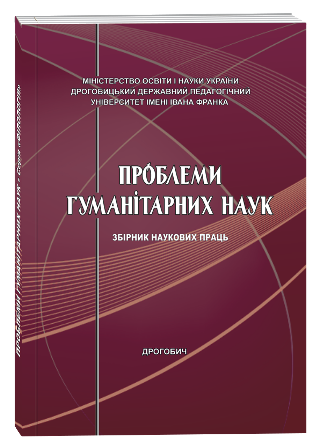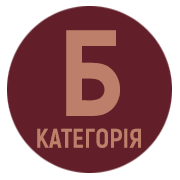WHO IS THE MAIN FEMALE CHARACTER IN THE ENGLISH NOVEL? (BASIC TYPES OF FEMALE CHARACTERS OF THE ENGLISH NOVEL OF THE XVIII–XXI C.: PSYCHO-LINGUISTIC ASPECT)
DOI:
https://doi.org/10.24919/2522-4565.2022.49.27Keywords:
female character, pink character, wicked character, assertive character, English novel, gender, socio-psychological type.Abstract
The present work looks at the study of the main types of leading feminine characters depicted in the English novel in the diachrony of the 18th–21st centuries Changes in time are also characterized by changes in cultural values and social roles in the society. Women have actively stated their intentions to eliminate discrimination and equalize their rights with men. The growing social and psychological status of women in the English-speaking society has focused attention of both writers and readers on a new type of character in literature. Despite the scholars’ great interest in gender representation of the main characters in the novels, neither their socio-psychological types, nor their verbal peculiarities have been highlit enough in the special literature. The main challenge of our study is to reveal the essential characteristics and formation of basic types of female heroines in the English novel during the 18th-21st centuries. In the process of work there were traced the system of three anthropocentres in the novel , specified the concept of “character” in literary semantics, clarified three types of the main female characters represented in the English novel and singled out essential characteristics of each of them. The well-known literary females are close und understandable to the readers not only due to their positive features, but also because of other personal traits, like bravery, audacity, cunningness, slyness, etc. We shall argue that the three basic literary female types conditionally termed (after D. Rampton, 2019) as ’pink’, ’wicked’ and ’assertive’ travel in time in the English literature and transfer from images of women who lived many years ago, into our contemporaries. It is still easy for the readers to recognise and identify them by means of their verbal and non-verbal behaviour as shown by the authors of the novels. The prospects of the study are to carry out a linguistic-psychological experiment for the purpose of establishing British national preferences in the sociio-psychological type of the female literary character, and thus, outline the virtual ideal of the English woman in general.
References
Античні поетики. Аристотель. Поетика. Псевдо-Лонгін. Про високе. Горацій. Про поетичне мистецтво / упоряд. М. Борецький, В. Зварич. Київ : Грамота, 2007. 168 с.
Бахтин М. М. Проблемы поэтики Достоевского. Москва-Augsburg, 2002. 167 c.
Бехта І. А. Оповідний дискурс в англомовній художній прозі : типологія та динаміка мовленнєвих форм : дис. … д-ра філ. наук : 10.02.04 / Київський національний університет імені Т. Шевченка. Київ, 2010. 526 с.
Богомолов А. Ю. Языковая личность персонажа в аспекте психопоэтики : на материале романа Л. Н. Толстого «Анна Каренина» : дисс. … канд. фил. наук : 10.02.01 / Череповецкий государственный университет. Череповец, 2005. 207 с.
Бондаренко Я. О. Дискурс акцентуйованих мовних особистостей : комунікативно-когнітивний аспект : дис. … канд. філ. наук : 10.02.04 / Київський національний лінгвістичний університет. Київ, 2002. 143 с.
Борисова Т. С. Лінгвостилістичні засоби створення образу стереотипного персонажа (на матеріалі англомовної пригодницької прози ХІХ–ХХ ст.) : автореф. дис. … канд. філ. наук : 10.02.04. Одеса, 2002. 19 с.
Буцикіна Н. Є. Лінгвокогнітивний та комунікативний аспекти внутрішнього мовлення персонажів (на матеріалі художньої прози Ф. Моріака) : автореф. дис. … канд. філол. наук : 10.02.05. Київ, 2004. 19 с.
Гинзбург Л. Я. О литературном герое. Ленинград, 1979. 224 с.
Ґреймас А. Ж. Размышление об актантных моделях. Вестник Московского Университета. Серия 9. Филология. Москва, 1996. № 1. С. 118–135.
Гураль О. Ю. Концепт «персонаж» : спроба когнітивного аналізу. Вісник Сумського державного університету. Філологічні науки. Суми, 2005. Вип. 5 (77). С. 109–114.
Карасик В. И. Языковой круг : личность, концепты, дискурс. Москва : Гнозис, 2004. 390 с.
Караулов Ю. Н. Русский язык и языковая личность. Москва : Наука, 1987. 262 с.
Колегаєва І. М. Зображення персонажного дискурсу як жанрово детермінований вияв комунікативної вторинності в художньому тексті. Вісник ХНУ ім. В. Н. Каразіна. Харків, 2010. Вип. 61 (896). С. 102–107.
Колісниченко Н. Ю. Лінгвопоетика німецько-та англомовних романів (romance, романс): гендерний аспект : дис. … канд. філ. наук : 10.02.04 / Одеський національний університет ім. І. І. Мечникова. Одеса, 2008. 248 с.
Літературознавчий словник-довідник / редкол.: Р. Т. Гром’як, Ю. І. Ковалів та ін. Київ : ВЦ «Академія», 2007. 752 с.
Лотман Ю. Текст у тексті. Антологія світової літературно-критичної думки ХХ століття / за ред. М. Зубрицької. Львів : Літопис,1996. С. 430–441.
Морозова І. Б., Єршова К. І. Лінгвальні засоби вираження емотивності в жіночому романі. Мова. Одеса, 2019. № 31. С. 20–26. Паскова Н. А. Концепт ЖЕНЩИНА. Антология концептов / под ред. В. И. Карасика, И. А. Стернина. Том 2. Волгоград : Парадигма, 2005. С. 132–146.
Постмодернизм. Энциклопедия / под общ. ред. А. А. Грицанов, М. А. Можейко. Минск : Интерпрес-сервис; Книжный дом, 2001. 1040 с.
Пожарицька О. О. Авторський концепт позитивності у мовленнєвому портреті головного героя : комунікативно-парадигматичний аналіз : автореф. дис. … канд. філол. наук : 10.02.04. Одеса, 2014. 20 с.
Cкідан О. Г. Контрастивні стилістичні засоби втілення концепту ТВОРЧА ОСОБИСТІІСТЬ у художніх текстах У. С. Моема : автореф. дис. … канд. філол. наук : 10.02.04. Харків, 2007. 20 с.
Томашевский Б. В. Теория литературы. Поэтика : учеб. пособие. Москва : Аспект Пресс, 1996. 334 с.
Bal M. Narratology : introduction to the theory of narrative. Toronto : University of Toronto Press, 1997. 254 p.
Bortolussi M., Dixon P. Psychonarratology : foundations for the empirical study of literary response. Cambridge : Cambridge University Press. 2003. 304 p.
Chatman S. Story and Discourse : Narrative Structure in Fiction and Film. Ithaca, NY : Cornell University Press, 1980. 277 p.
Dictionary of Narratology / by G. Prince. University of Nebraska Press, 2003. 144 p.
Fishelov D. Methaphors of Genre : the role of analogies in genre theory. USA : Pennsylvania State University, 1990. 188 p.
Forster E. M. Aspects of the novel. Harmondsworth : Penguin, 1963. 141 p.
Hamon P. On semiologic status of character. Critical Essays / trans. by R. Howard. Evanston : Northwestern University Press, 1972. P. 117–163.
Hochman B. Character in Literature. UK : Cornell University Press, 1985. 204 p.
Hundert А. Rethinking the Strong Female Character. Critical Essays. The Ploughshares, 2017. URL: https://blog.pshares.org/rethinking-the-strong-female-character/ (дата звернення: 24.12.2021).
Keel S. The Greatest Female Characters In Literature. UК, 2014. 245 p.
Leavy P. Chick-lit, Science and Feminism? The creativity post. Nov. 09, 2014. URL: https:// www.creativitypost.com/article/chick_lit_science_and_feminism (дата звернення: 20.11.2021).
Liljestrоm M. Sukupuolijarjestelma. Avainsanat. Tampere, 1996. P. 118–130.
Margolin U. Characterisation in narrative : some theoretical prolegomena. Neophilologus. 1983. № 67. P. 1–14.
Margolin U. Individuals in Narrative Worlds : An Ontological Perspective. Poetics Today. 1990. № 11 (4). Р. 843–871.
Margolin U. Introducing and Sustaining Characters in Literary Narrative : A Set of Conditions. Style. 1987. № 21 (1). P. 107–124.
Margolin U. Structuralist Approaches to Character in Narrative : The State of the Art. Semiotica. 1989. № 75 (1-2). P. 1–24.
Meаd G. Representation of fictional character. Style. 1990. Vol. 24 (3). Р. 440–462. Palmer A. Fictional Minds. Lincoln and London : University of Nebraska Press, 2004. 273 p.
Pearson C., Pope K. Toward a typology of female portraits in literature. CEA Critic. 2005. Vol. 37. No. 4. P. 9–13.
Rampton D. From Shakespeare to Rowling. Literary Semantics : Brighton Readings. 2019. Vol 35. P. 341–367.
Richardson S. Kinkead-Weekes M. Pamela. A collection of critical essays. N.J., 2009. 121 p.
Rimmon-Kenan Sh. Narrative Fiction. London, New York : Contemporary Poetics, 2002. 181 p.
Ryan M. L. Possible Worlds, Artificial Intelligence, and Narrative Theory. Bloomington : Indiana University Press, 1991. 291 p.
Savitt J. D. Female Stereotypes in Literature (With a Focus on Latin American Writers). Yale-New Haven Teachers Institute, 1982. Vol. 5. URL: https://teachersinstitute.yale.edu/curriculum/ units/1982/5/82.05.06.x.html (дата звернення: 10.10.2021).
Thomas S. The great chick lit conspiracy. The Independent, 2002. URL: https://www.independent.co.uk/ arts-entertainment/books/features/the-great-chick-lit-conspiracy-172223.html#comments-area (дата звернення: 16.11.2021).
Thornton А. Women’s fiction why not? / Ed. by G. Tibballs. Running Press Book Edition. London, 2010. 169 p. Weinsheimer J. Theory of Character : Emma. Poetics Today. 1979. № 1 (1-2). Р. 185–211.
Werth P. Text worlds : representing conceptual space in discourse. Longman, 1999. 390 p.
Wolff C. Gr. Female Literary Characters: Basic Types and Images. USA : Massachusetts University Press, 2005. 321 p.



